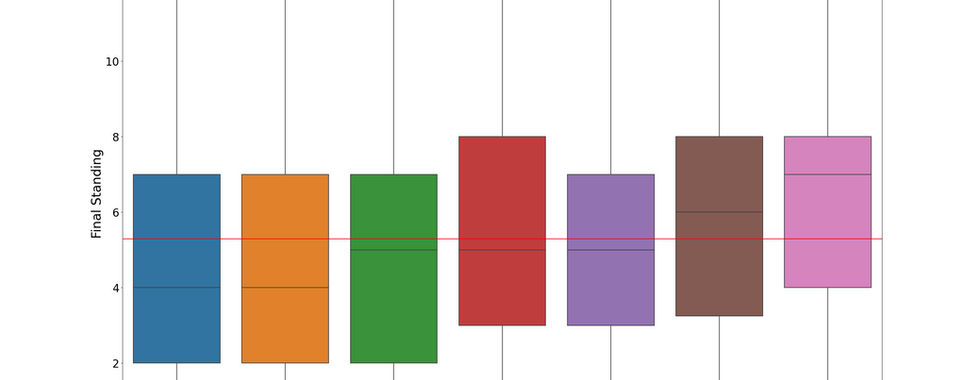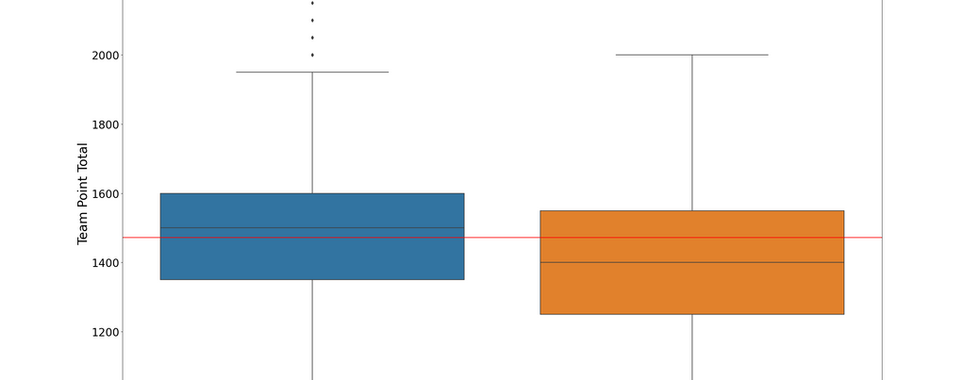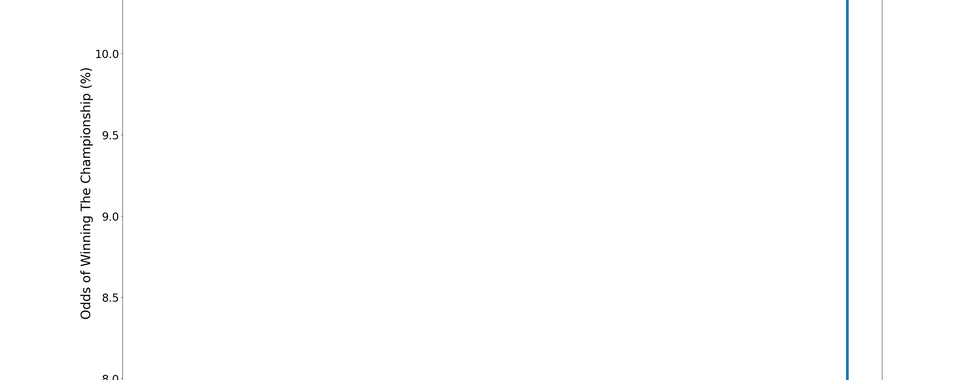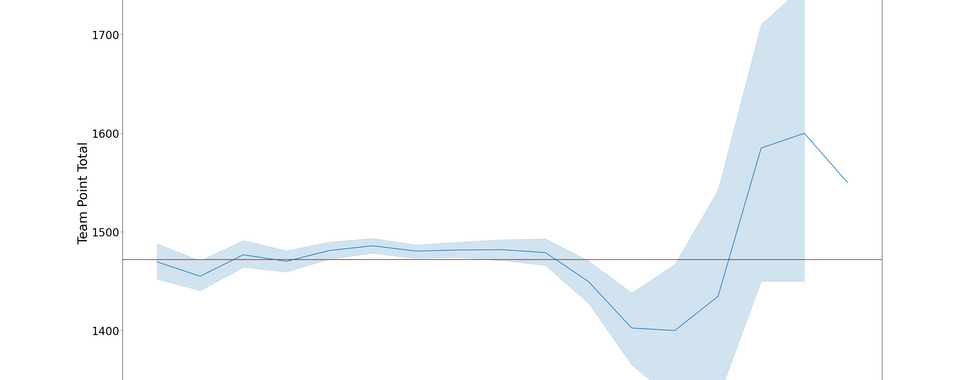2020 Draft Strategy Recap: Snake Drafts
- Alex Cates
- Jan 12, 2021
- 9 min read
Updated: Aug 23, 2022
Note also check out 2020 auction draft strategies and a 3 year review of snake draft strategies
Now that the season is over, we can look back and see how different draft strategies worked out this year. Does it matter which pick you had? Should you have drafted a TE or WB early or waited? Was it better to go RB heavy or Zero RB? Obviously, you have to pick the right players (McCaffrey, Barkley, and Zeke were all consensus top 3 picks and none of them worked out), but having the right strategy is also important. So today I want to look at how a couple of common strategies worked out across ESPN Leagues. Note: This post will be mostly a surface level investigations of a few different strategies. Future posts may take a deeper dive into individual strategies to understand why they did or did not work this year.
The Data
As always, we can gather the drafts from public ESPN leagues. This time I am using the draft and final standing results from about 2000 different leagues, providing about 19,000 individual teams to judge from. I did go and filter the teams a little, specifically only including leagues with 12 or fewer teams and filtering team point totals to remove outliers (both high and low) which likely signified unusual scoring rules that would impact the draft strategy. Let's start with what slot was the best to have picked from.
Where should you have picked from?
The first question we can look at is the classic, Which slot should you have drafted from? This isn't necessarily trying to define the optimal slot (if you knew exactly who to draft), but should give us a sense of which slot gave you the best chance of winning
The first 3 plots show the mean (with shaded 95% confidence interval) of Final Standing, wins, and points for vs which slot you picked from. The red line represents the mean performance regardless of the pick slot. The final graph shows a lollipop chart of your odds of winning the championship from each pick slot. The red line shows your odds of winning if the champion was chosen via random chance.
Looking across all the graphs, we can see that your draft slot did matter. Now for most positions, it did not matter that much, but it was clearly better to have picked 4-7. This was true whether you go by points, wins, final standing, or odds of winning it all. I think looking in terms of odds of winning it all is the most revealing, with the middle picks slots 4-8 had odds better than random chance (1/12 or 8.3%) while the rest were average (slots 1-3) or worse. This probably has a lot to do with how injuries worked out this year. The consensus top 3 picks in most leagues were Christian McCaffrey (injured), Saquon Barkley (injured), and Ezekial Elliot (underperformed likely due to injuries to the rest of the offense). Compare that to the consensus 4-8 (Dalvin Cook, Alvin Kamara, Derrick Henry, and Michael Thomas) and we can see that 3 of those players were studs all year long (with Michael Thomas being the exception). Overall, This is kinda what I expected, given that there was a clear tier drop in players around the 8th pick and the injuries to the top 3.
Early vs Late QB
Note for a deeper dive into 2020 QBs, see my post here
Everyone preaches that you should wait on QB. That there is always some waiver wire add that you can get away with (Justin Herbert this year) or that you can just stream QBs (a discussion for another day). But what strategies worked this year? To investigate we can group teams based on the round in which they took their first QB as shown below
The first 3 plots show the mean (with shaded 95% confidence interval) of Final Standing, wins, and points for vs when you drafted your first QB. The red line represents the mean performance regardless of the pick slot. The final graph shows a lollipop chart of your odds of winning the championship if you drafted your first QB in a specific round. The red line shows your odds of winning if the champion was chosen via random chance.
That is not the graph I was expecting. I have been following the idea of the late QB strategy for years, and frankly taking it to the extreme assuming that I can stream a QB into competence but that's not what worked this year. While you don't want to spend a 1st or 2nd on a QB (so no Patrick Mahomes or Lamar Jackson this past year), but the second tier of QB was the way to go (Kyler Murray, Dak Prescott, or Russel Wilson). Again, this is supported regardless of what metric you go by. Most striking to me though is that after the first 2 rounds, it was basically the earlier the better. I doubt that this means that you should reach for a QB, but at the same time it is starkly against the idea of waiting on a QB
Early vs Late TE
The same debate on when to take a QB rages with TE. There is a slight change in that the consensus is that you basically want to be first or last. There are top-tier TE's (Travis Kelce and George Kittle this past year), there maybe a second tier (Mark Andrews, Darren Waller, or TJ Hickinson this past year), but it's likely better to wait because they are all a crap shoot. But what does the data say? Same as QB, we can group teams based on when they took their first TE.
The first 3 plots show the mean (with shaded 95% confidence interval) of Final Standing, wins, and points for vs when you drafted your first TE. The red line represents the mean performance regardless of the pick slot. The final graph shows a lollipop chart of your odds of winning the championship if you drafted your first TE in a specific round. The red line shows your odds of winning if the champion was chosen via random chance.
Again kinda surprising. Similar to QB, the earlier you took a TE the better. However, unlike QB, this includes the top tier (since Kelce and Kittle's Average draft positions were in the 2nd round). Basically, as long as you don't take a TE in the first round, the sooner you took a TE, the better. This is really interesting because it is exactly against the consensus advice. I think that is especially interesting when you get outside the top flight TEs. The TE landscape was awful this year (as it often is), and yet the earlier you drafted a TE the better chances you had at winning the league.
What Positions to Target in the First and Second rounds
When we talk draft strategy, a lot of the talk is about what positions to take with your first couple picks. Do you go RB heavy? Balanced? Zero-RB? Do you risk taking a TE or QB? We've already touched on when to draft a TE or QB (go after the TE, wait for the second tier of QBs), but what pairs should you go with? Below I have grouped teams by what positions they took with their first 2 picks. I've also only included the primary pairs (to throw out a couple more chaotic leagues).
The first graph shows a lollipop chart of your odds of winning the championship depending on what positions you drafted in the first 2 rounds. The red line shows your odds of winning if the champion was chosen via random chance. The other 3 boxplots show Final Standing, wins, and points for vs what positions you drafted in the first 2 rounds. The red line represents the mean performance regardless of the pick slot.
Looking at the position splits here a couple of things that jump out. First, going RB then TE was the best choice, going along with the results from when to draft a TE. RB then WR was second, while WR/TE, RB/RB, and RB/QB providing near random odds. Its important to note that WR/WR (the most common start in a zero RB strategy) and WR/QB both really hurt your chances of winning the championship. This is not to say that you can't win with any of these options, but if we talk about your best chance, it seems like RB in the first is your best chance.
Zero RB
While the last section looked at the top 2, this is not necessarily indicative of a zero RB strategy. I think a safer comparison would be looking at the top 4 picks. I think it's safe to say anyone who does not take an RB in the first 4 rounds is following a zero RB strategy.
The first 3 boxplots break down the Final Standing, wins, and points for depending on if the manager followed a zero RB strategy or not. The red line represents the mean performance regardless of the pick slot. The final graph shows a lollipop chart of your odds of winning the championship if you followed a zero RB strategy or not. The red line shows your odds of winning if the champion was chosen via random chance.
And the results are pretty stark. Going Zero RB hurt your chances at winning the championship. Again I am not saying that you cant win with zero RB, it is a totally acceptable strategy, but in terms of what is most likely to happen, you want to get top-tier RBs. It's that simple.
Value Drafting
One final strategy to cover is the idea of value drafting. Similar to taking the "best player available" in the real NFL draft, Value drafting is all about grabbing players after their average draft position (ADP). We can therefore quantify the value of a draft pick by subtracting a player's ADP from when they were actually drafted. To look at value drafting I will look over 2 different time ranges, the sum of value across the first 6 picks and across the entire draft.
The 3 plots show the mean (with shaded 95% confidence interval) of Final Standing, wins, and points for vs how much ADP value you accrued across the first 6 rounds. The red line represents the mean performance across all teams.
Starting with the top 6, we actually can see that value does not really matter. most teams are in the -20 to +20 range and it does not really seem to help. This basically means you should feel free to target the players you like (remembering the positional targets we talked about earlier) and not worry about if it is a reach or not.
The 3 plots show the mean (with shaded 95% confidence interval) of Final Standing, wins, and points for vs how much ADP value you accrued across the entire draft. The red line represents the mean performance across all teams.
Overall it looks like that trend holds across the entire draft. If anything you are better going and reaching on players later in the draft and just making sure you get your guys. I'm kinda surprised by this, though I wonder what the ADP range being considered at any point in the draft is. Regardless, the message is clear, go and get the players you want and don't worry about what their ADP may be.
Limitations
The obvious limitation of this analysis is that I am not looking at who you choose, just what positions you target and when. You still have to choose the right players. However the point of this is that the right players will change every year, but finding the right strategy to follow will certainly help in any given year. Relatedly though, this is just one year's worth of data. Every year is different and this year may have been more of an anomaly than most because of covid. At the same time, understanding what worked across leagues is better than understanding what worked in your league.
A second limitation is I do not have any control over how good the managers are at fantasy football, the draft is only a start and you need to manage your team well in order to win. There are a lot of factors (such as coaching decisions, roster management, and straight-up luck) that can impact how a fantasy team does throughout the year. Hopefully, the sheer sample size will deal with most of those, but we don't know for sure.
I think a final limitation is that every league is different. The value of players, positions, and strategies will change depending on your rule settings and what the other managers are doing. QB streaming is great until everyone is doing it and the waiver wire is picked clean. Same for zero RB or any other strategy. The best approach may be to be different than the rest of your league (though that opinion is not supported by data yet).
Conclusions
Overall, I think there are a couple of clear takeaways.
Don't worry about your draft slot
Target the second tier of QBs
Don't be afraid to reach for a TE
Try to get an RB in the first round
Be wary of the zero RB hype
Go get the players you want
I do want to reiterate that I am not saying that going against these strategies cant work, in fact, they did work for hundreds of teams. But if we look at what worked most often and try to follow that, I think there is value in looking at the aggregates like this.
Questions? Comments? Let me know at ac@alexcates.com. Want to read more breakdowns like this? sign up for my newsletter. Finally, like what I do? Consider supporting me on buy me a coffee.






















































Comentarios